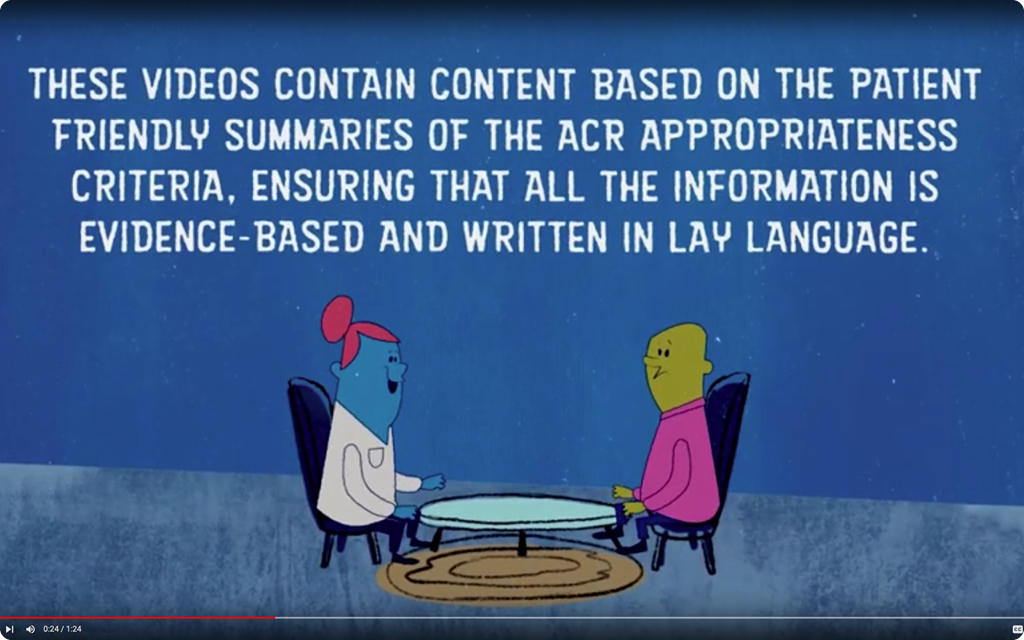The ACR has long strived to assist referring physicians in educating patients about imaging. The idea is that patients will be more likely to have appropriate imaging if they know exactly what they are getting into and why it helps. To facilitate this, the ACR Commission on Patient- and Family-Centered Care (PFCC) has created a series of short videos to help educate patients about imaging tests. The Bulletin caught up with Nina S. Vincoff, MD, co-chair of the PFCC Patient Engagement Committee, to learn more about the animated video project and what she hopes it will accomplish.
What inspired the video series?
The PFCC Patient Engagement Committee is creating these short animations to answer common questions patients typically have about imaging. The goal is for patients to watch the animations for information and be able to participate in shared decision-making with their physicians. So far, we have about a dozen videos either finished or in production. We released two in October to coincide with Breast Cancer Awareness Month — one on breast cancer screening tests and what the differences are and who is appropriate for each, and another on whether patients should continue to have breast cancer screening if they’re pregnant or breastfeeding. We also released two in November to coincide with Lung Cancer Awareness Month.
Are the videos meant to prompt physicians to dig deeper into the ACR Appropriateness Criteria® summaries?
Our target audience for these videos is the patient, and we’re trying to serve two purposes. The first is just standalone content. You can watch these videos that are approximately one minute in length — consistent with the way many people seek information today and short enough to be posted on a variety of social media platforms. Second, the videos are available for viewing and sharing from the JACR® YouTube page, and links to the relevant patient-friendly summary and the full ACR Appropriateness Criteria® (AC) document can be found in the YouTube caption for each video. That summary has more information than we could contain in a one-minute video. Nearly 100 patient-friendly summaries have been published by the JACR and are available at acr.org.
So far, we have released videos to coincide with Breast Cancer and Lung Cancer Awareness Months and will continue to release more timed content over the course of the year.
Were patients involved in the development of the series?
The video scripts were written by the radiologist members of the PFCC Patient Engagement Committee, but the source content for the videos comes from the ACR AC patient-friendly summaries, which are authored by patients. The patient-friendly summaries are written by the ACR AC Patient Engagement Subcommittee, which I also chair. On that committee, layperson authors, who are recruited and supported by Andrea Borondy-Kitts, MS, MPH, work together with radiologist technical authors to create evidence-based lay-language summaries of the ACR AC.
What’s your vision for the future of the video series?
Right now, the first goal is to 1) make more videos and 2) coordinate them with awareness months. When we first started talking about the videos, we had all this content and asked, “Which ones
do we want to turn into videos?” We started looking at awareness months on the calendar and we said, “When might patients be looking for content?” We thought they might be looking for content at a time that’s getting a lot of play in the media. So, we created an editorial calendar tied to awareness months. So far, we have released videos to coincide with Breast Cancer and Lung Cancer Awareness Months and will continue to release more timed content over the course of the year.
The next step is to use social media to promote the videos. The step after that is to partner with patient advocacy groups to take these messages into their communities. Another thing we really need to start thinking about is how we can make these videos available to radiology practices and, even more important, to referring physicians. If our goal is to help patients to partner with their physicians in a more effective way for shared decision-making, we should be providing these resources to our referring doctors so they can share them with their patients.
Linda Sample, BCPA, CPXP, co-chair of the Patient Engagement Committee, and I encourage ACR members to keep an eye out for new videos and consider sharing this great new resource with your referring providers and patients.

